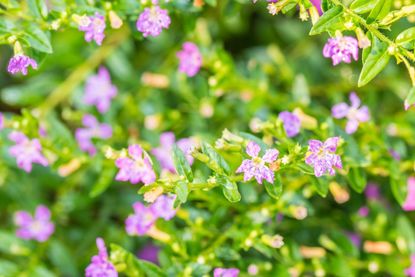What Is A Mexican Heather Plant: Tips On Growing Mexican Heather Plants


What is a Mexican heather plant? Also known as false heather, Mexican heather (Cuphea hyssopifolia) is a flowering groundcover that produces masses of bright green leaves. Small pink, white, or lavender flowers decorate the plant throughout most of the year. Mexican heather plants, which actually aren’t members of the heather family, are suitable for growing in the warm climates of USDA plant hardiness zones 9 to 11. You can grow Mexican heather as an annual if you live in a chillier climate.
How to Plant Mexican Heather
Planting Mexican heather is uninvolved, although the plant benefits from a little added compost or manure if soil is poor. Allow at least 18 inches (46 cm.) between each plant. This tough, drought tolerant plant loves direct sunlight and thrives in intense heat. Remember that although Mexican heather plants grow in a wide range of soils, good drainage is critical.
Care of Mexican Heather
Water Mexican heather plants deeply about once every week, then allow the soil to dry slightly before watering again. Container plants will need water more often, especially during the summer months. Prune Mexican heather lightly during the spring if the plant looks scraggly or overgrown. Otherwise, no pruning is required. Surround the plant with a thin layer of mulch in spring to minimize moisture evaporation and keep weeds in check. Feed the plant in spring, summer, and fall using a balanced, general-purpose fertilizer. Healthy Mexican heather plants are seldom bothered by insects. However, if you notice spider mites during hot, dry weather, treat the pests with insecticidal soap spray on a day when the sun isn’t directly on the plant. Insecticidal soap spray with a few drops of rubbing alcohol will also take care of flea beetles.
Gardening tips, videos, info and more delivered right to your inbox!
Sign up for the Gardening Know How newsletter today and receive a free download of our most popular eBook "How to Grow Delicious Tomatoes."

A Credentialed Garden Writer, Mary H. Dyer was with Gardening Know How in the very beginning, publishing articles as early as 2007.
-
 7 Best Trailing Plants For Hanging Baskets – Create A Delightful Summer Display
7 Best Trailing Plants For Hanging Baskets – Create A Delightful Summer DisplayHanging baskets are a staple of the summer patio. Use these plants to create trailing masterpieces that add beauty and elegance to your outdoor space.
By Melanie Griffiths
-
 Old-Fashioned Flowers And Plants That Will Transport You To Another Time
Old-Fashioned Flowers And Plants That Will Transport You To Another TimeFancy bringing some old world beauty and elegance to your space? These nine old-fashioned flowers can help you add a touch of nostalgia and romance
By Mary Ellen Ellis